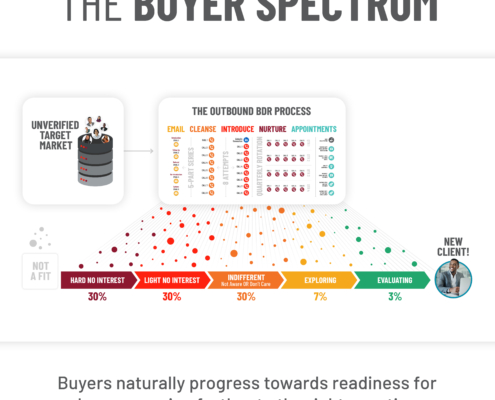

Many sales development teams struggle with effectively following up with prospects in the sales pipeline. They often don’t know how to follow up lead management process without being annoying or take too long to reach back out because they fear they may be stepping on toes.
While both are very real fears and concerns to have, there are some creative lead nurturing ideas that sales development teams can use to reach the right prospects at the right time, increasing the likelihood of scheduling sales meetings and closing more deals.
Some of the best ways to follow up with sales leads in your pipeline include:
Use a Variety of Sales Follow-Up Methods
There are many ways to follow-up with prospects, like making phone calls or sending emails. While many sales teams may prefer one follow up method over another, taking advantage of both approaches helps you get the most out of your sales efforts and effectively move leads through the sales funnel.
For example, if you’ve called a hot HVAC lead three to four times and you’ve had no luck getting them on the phone, send them an email with relevant content and your contact information so they can reach you when they’re ready. On the other hand, if you’ve sent them a couple of emails, consider calling them to see if you can get a hold of them. Taking advantage of various sales follow-up methods increases your likelihood of setting up an appointment between them and your account executive (AE).
While phone calls and emails are the most common ways that sales development representatives (SDRs) follow up with prospects, some sales teams like to use social media platforms to connect and nurture leads. LinkedIn is designed to be a business networking platform, so why couldn’t you use this for your lead nurturing strategy? When used correctly, LinkedIn is an incredibly powerful lead generation tool that can maximize your ROI and accelerate the customer’s experience with your business.
Space Out Your Sales Follow-Up Efforts
One of the biggest fears of cold calling is being too invasive and disruptive of the potential customer’s workday. So, when you space out your sales follow-up efforts, you can be professionally persistent and only call them when it’s relevant.
For example, if a lead for your commercial cleaning company says their contract ends in three months and to follow up then, you wouldn’t call them back every two weeks to see where they are in their evaluation process. It’s important to respect the space and the boundaries of your prospects. When you don’t space out your follow-up efforts, you risk losing hot leads. Following up multiple times in a row too frequently could turn off potential clients from your company.
One of the most effective ways to space out your follow-up efforts is to take advantage of a customer relationship management (CRM) platform. By using a CRM platform like Salesforce Sales Cloud, you can set a date to call the prospect back. This ensures that you follow up with them when the timing makes the most sense.
For more insight into how you can use Salesforce for lead generation efforts, read our blog here.
In addition to spacing out sales follow-up efforts, you should create a follow-up schedule. This makes sure that you’re not checking in with prospects too frequently and allows you to connect with leads when they’re in the office.
For example, if you caught the prospect for the first time in the morning, call them in the morning when you follow up because they’ll more than likely be available and in the office. Since business hours range from region to region, it’s also important to remember the time zones you’re calling and their typical business hours. Setting up a follow-up schedule helps you connect with the right prospect at the right time.
Provide Value With Each Sales Follow-Up
Lead nurturing involves adding value to every conversation you have with the prospect after the initial phone call. Since we know that not every prospect says “yes” after initial contact, SDRs have to give them a reason to say yes.
If the prospect says they respect company missions and values, the first layer could be going in-depth with your company history. If the prospect emphasizes that their current provider is capable of completing a variety of tasks, the second layer could be highlighting your product and service offering. If the lead wants to learn more about work you’ve done with companies like theirs, the third layer could be explaining a client testimonial. As you add more layers, the more appetizing your company looks. While each company may have different layers, the process of nurturing a lead is essentially the same and leads you to the results you want.
The point is while it would be great if the prospect said “yes” to an additional meeting, the conversations that build up during the lead nurturing process continue to get better and better. This will lead you to a more qualified and value-focused appointment. In addition to the prospect agreeing to the meeting, this also reduces the no-show rate because it gives them a reason to attend the appointment with your AEs.
Here are topics of discussion to provide value in your sales follow-up efforts:
- Company history
- Products or services delivered
- Process of completing product or service
- Client testimonials
- Statistics (such as the number of clients, projects delivered, client retention rate, etc.)
While sales reps can verbally promote these topics of discussion, marketing collateral is a great addition to your B2B appointment setting efforts because it supports your business in a more visually appealing way. Marketing collateral includes different types of eye-catching materials that represent your company, like brochures, sell sheets, white papers, promotional videos, and more. These can be sent to prospects in an email or embedded into your website to help them reach the end of their buyer’s journey.
In addition, a sales pitch deck can be used by AEs during appointments set by SDRs to keep the potential customer engaged throughout the sales presentation.

Define the Next Steps
While there are a lot of prospect follow-up mistakes that SDRs make, one of the biggest is not defining the next steps the prospects need to follow. The next steps could include saying, “I’m going to send over an email with some dates and times. Let me know what works best for you. If I don’t hear back, I’ll give you a call a week from today to touch base. Does this time usually work for you?”
When defining the next steps, be as specific as possible. Don’t use vague terminology like “I’ll call you next week.” Be sure to include various times or dates. By giving a specific date and time, they can anticipate your call.
Write Action-Focused Subject Lines in Sales Emails
If you’re sending a follow up email, you should write a strong subject line that encourages them to open the message. Business owners receive emails all the time, and most of them never get opened because they don’t apply to them. When you have an action-focused subject line, they’re more likely to open the email because they believe they need to do something for it.
In addition to being action-focused, personalize the subject line with their personal or company name so they know it’s specific to them. A prospect is much less likely to open a generalized email because they know it’s also being sent to other businesses like theirs.
Here are some best practices for writing email subject lines:
- Keep it short and to the point
- Use a conversational, personable tone
- Develop a sense of urgency
- Ask a direct question
- Make it clear that the email contains valuable content
An effective subject line could be what turns a lead into a customer. Nobody opens an email with a boring subject line, so make sure yours stands out and is unique to their wants and needs.
For more sales email best practices, read our blog here.
Keep Sales Follow-Ups Brief
Business owners and key decision-makers (KDMs) are busy people, which means they don’t have a lot of time to spend reading long emails or talking on the phone for a sales follow-up. When you follow up with prospects, remember to keep the conversation engaging, yet brief and to the point. During this short timeframe, make sure you grab the prospect’s attention and make them want to take additional actions.
Know When To Stop Follow-Ups on a Lead
As much as we hate to see it, breaking up with qualified leads can be hard but necessary. Leads can only be leads for so long until they either convert into customers or tell you that they’re no longer interested in your product or service. When they say they’re no longer looking for a solution or ghost you overall, respect them and their time.
When a lead is no longer interested or leaves you on read, don’t be aggressive or try and sell them harder. Respect their space and let them know that the door is always open if things don’t work out with their current service provider. This puts your company in a good light and leaves things on a positive note.
While you decide to give them space, this doesn’t mean that you have to remove them from the sales pipeline. Timing is everything in the sales industry. Even though they’re not looking for your product or service right now, it doesn’t mean they won’t be interested in the future. Keep the prospect in the sales pipeline and follow up a few times a year just to see how things are with their current provider. Use this time to identify pain points and what they expect out of an outsourced service provider.
Key Takeaways
Lead nurturing is essential to build and sustain your sales pipeline because it allows you to follow up with prospects when they’re ready to make moves through the sales funnel. When you use advanced sales tools and technologies like Salesforce, the lead nurturing process is much more streamlined than if you were to follow up with leads by marking your calendar.
While many businesses believe that cold calling is dead, we’re here to tell you that it’s alive and well—but only when it’s practiced correctly. By following our best practices for sales follow-ups, you increase the likelihood of converting sales leads into long-term customers. But if a lead isn’t biting, respect their space and put them in the back of the sales pipeline.
Do you want to optimize the way you follow up with sales prospects in your B2B appointment setting efforts? Contact our sales reps at Abstrakt Marketing Group!




